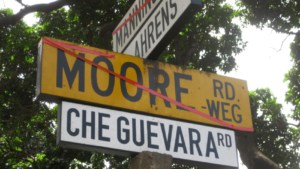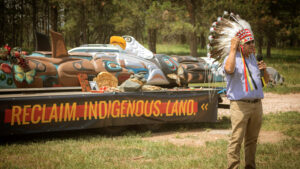The House of Tears Carvers and our partners on the Red Road to DC will hold a blessing ceremony on July 21st, 2021 in the Black Hills, as we continue our journey to draw attention and action to sacred sites and Indigenous rights.
This event is not open to the public. Please contact our host committee if you would like to be involved in ceremony. You can also join the journey here by taking action to return the Black Hills to the Oceti Sakowin:
https://redroadtodc.org/actions/action-2/
The Black Hills stretch across western South Dakota, northeast Wyoming and southeast Montana and constitute a sacred landscape for the Lakota, Northern Cheyenne and Omaha. To the Lakota, they are Paha Sapa, “the heart of everything that is.” The Black Hills were the casualty of one of the most blatant land grabs in U.S. history and continue to be the site of a legal and political confrontation.
“Mount Rushmore is on stolen Lakota land and its very existence is a symbol of white supremacy” says Nick Tilsen, NDN Collective President and CEO. “In opposing the ongoing desecration of our sacred land and asking for return of Lakota lands where Mount Rushmore is situated, we’re not saying anything that our parents, grandparents and great grandparents haven’t already said– The Lakota have opposed Mount Rushmore since the very beginning.”
“Indigenous people have resisted colonization for the past 500 years,” says Tilsen. “Colonization is the oldest form of white supremacy, and America is being called out and called up to acknowledge that. Mount Rushmore is yet another symbol of white supremacy and colonization, and until it is returned to the Lakota, we will continue to oppose it and fight for justice.”
Source: NDN Collective
“The Black Hills have been sacred to the Lakota and other native people for thousands of years, known as a place of extraordinary spiritual power. Within the Norbeck Wildlife Preserve lies Harney Peak, described by Lakota spiritual leader Black Elk as “the Center of the World.” Logging roads are now being built in this landscape, destroying sacred places that cannot be restored. The logging itself will have long-term impacts on old-growth trees, associated water systems and wildlife.
Over the years, the Black Hills have experienced mining, logging, and recreational uses, often in violation of Lakota beliefs. Mining for gold, coal and uranium pollutes water. Cyanide heap-leach gold mines, such as Homestake and Gilt Edge, use cyanide to extract gold from crushed ore. The cyanide mixes with other chemicals, producing toxic chemicals which can leach into the groundwater. This sort of mining leaves huge open pits which scar the landscape, and frequently the companies are allowed to abandon the mines without cleaning up or restoring the land to its original state.”
Source: Sacred Land Film Project
RESOURCES
NDN Collective
https://landback.org/
The Red Road to DC: A Totem Pole Journey for the Protection of Sacred Places is a touring series of ceremonies, public events, media projects, and campaigns culminating in a rally on the National Mall and an exhibition developed by The Natural History Museum and The House of Tears Carvers at the Smithsonian National Museum of the American Indian.







